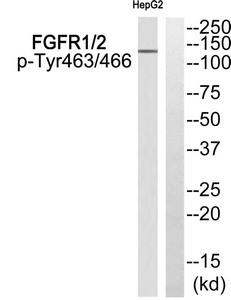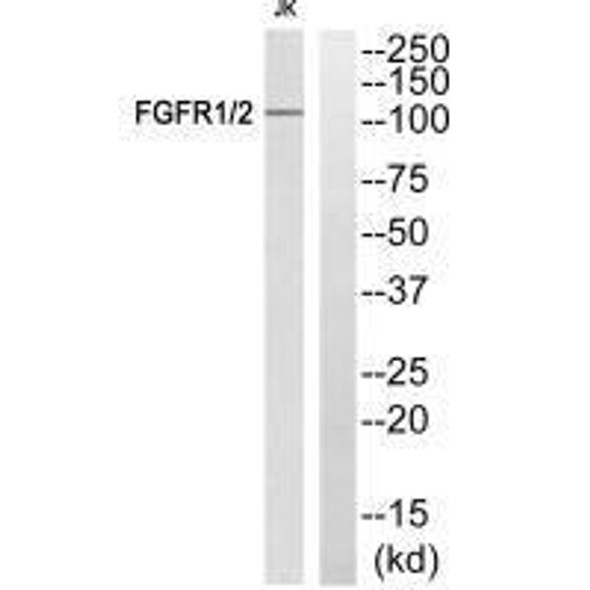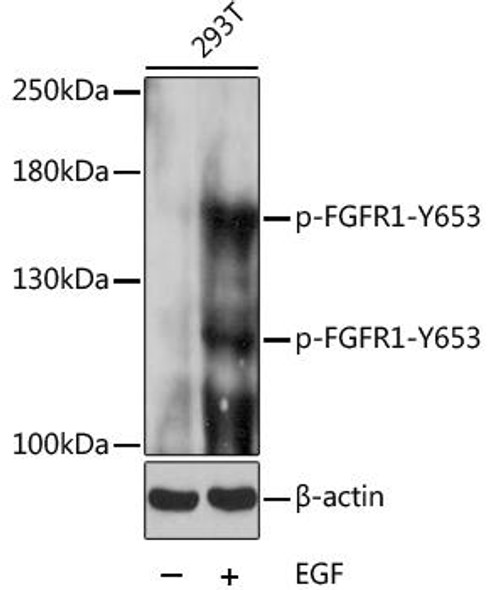Description
Phospho-FGFR1/FGFR2 (Tyr463/466) Antibody (PACO24133)
The Phospho-FGFR1/FGFR2 (Tyr463/466) Antibody (PAC024133) is a valuable tool for researchers studying the FGFR1 and FGFR2 signaling pathways. This antibody, produced in mice, specifically targets the phosphorylated tyrosine residues at positions 463 and 466 on FGFR1 and FGFR2 proteins. It has been validated for use in various applications, including Western blot and immunohistochemistry, enabling the detection and analysis of these phosphorylated forms of FGFR1 and FGFR2 in a wide range of cell and tissue samples.FGFR1 and FGFR2 are members of the fibroblast growth factor receptor family, playing crucial roles in cell proliferation, differentiation, and survival.
Phosphorylation of specific tyrosine residues like Tyr463 and Tyr466 is known to regulate the activity of these receptors, impacting various cellular processes. Understanding the phosphorylation status of FGFR1 and FGFR2 is essential for elucidating their signaling mechanisms and potential implications in diseases such as cancer, developmental disorders, and other pathological conditions.By using the Phospho-FGFR1/FGFR2 (Tyr463/466) Antibody (PAC024133), researchers can gain valuable insights into the activation status of FGFR1 and FGFR2 proteins, facilitating further studies on their functions and potential therapeutic targeting in various disease contexts.
| Antibody Name: | Phospho-FGFR1/FGFR2 (Tyr463/466) Antibody (PACO24133) |
| Antibody SKU: | PACO24133 |
| Size: | 100ul |
| Host Species: | Rabbit |
| Tested Applications: | ELISA, WB |
| Recommended Dilutions: | ELISA:1:2000-1:10000, WB:1:500-1:1000 |
| Species Reactivity: | Human, Mouse |
| Immunogen: | Peptide sequence around phosphorylation site of tyrosine 463/466(S-E-Y(p)-E-L) derived from Human FGFR1/2. |
| Form: | Liquid |
| Storage Buffer: | Rabbit IgG in phosphate buffered saline (without Mg2+ and Ca2+), pH 7.4, 150mM NaCl, 0.02% sodium azide and 50% glycerol. |
| Purification Method: | Antibodies were produced by immunizing rabbits with synthetic phosphopeptide and KLH conjugates. Antibodies were purified by affinity-chromatography using epitope-specific phosphopeptide. Non-phospho specific antibodies were removed by chromatogramphy using non-phosphopeptide. |
| Clonality: | Polyclonal |
| Isotype: | IgG |
| Conjugate: | Non-conjugated |
 | Western blot analysis of extracts from HepG2 cells using FGFR1/2 (Phospho-Tyr463/466) Antibody.The lane on the right is treated with the antigen-specific peptide. |
| Background: | The protein encoded by this gene is a member of the fibroblast growth factor receptor family, where amino acid, sequence is highly conserved between members and throughout evolution. FGFR family members differ from one another in their ligand affinities and tissue distribution. A full-length representative protein consists of an extracellular region, composed of three immunoglobulin-like domains, a single hydrophobic membrane-spanning segment and a cytoplasmic tyrosine kinase domain. The extracellular portion of the protein interacts with fibroblast growth factors, setting in motion a cascade of downstream signals, ultimately influencing mitogenesis and differentiation. |
| Synonyms: | BFGFR; CEK; FLG; CD331; FLT2 |
| UniProt Protein Function: | FGFR1: a receptor tyrosine kinase of the highly-conserved fibroblast growth factor receptor (FGFR). Binds both acidic and basic fibroblast growth factors and is involved in limb induction. Point mutations cause Pfeffer syndrome (finger and toe malformations and other skeletal errors) and dominant Kallmann syndrome 2. Stem cell leukemia lymphoma syndrome (SCLL) may be caused by a t(8;13)(p12;q12) translocation that fuses a zinc finger gene, ZNF198, to FGFR1. Various myeloproliferative disorders have been linked to translocations that fuse FGFR1 to FOP, FIM, CEP1 or the atypical kinase, Bcr. Inhibitor: SU5402. 20 isoforms of the human protein produced by alternative splicing have been described. |
| UniProt Protein Details: | Protein type:Protein kinase, TK; Protein kinase, tyrosine (receptor); Oncoprotein; EC 2.7.10.1; Membrane protein, integral; Kinase, protein; TK group; FGFR family Chromosomal Location of Human Ortholog: 8p11.23-p11.22 Cellular Component: integral to plasma membrane; cytoplasmic membrane-bound vesicle; extracellular region; plasma membrane; integral to membrane; nucleus; cytosol; receptor complex Molecular Function:heparin binding; identical protein binding; protein binding; fibroblast growth factor binding; protein homodimerization activity; fibroblast growth factor receptor activity; protein-tyrosine kinase activity; ATP binding Biological Process: paraxial mesoderm development; axon guidance; peptidyl-tyrosine phosphorylation; nerve growth factor receptor signaling pathway; protein amino acid autophosphorylation; cell maturation; neuron migration; negative regulation of transcription from RNA polymerase II promoter; middle ear morphogenesis; protein amino acid phosphorylation; positive regulation of MAP kinase activity; sensory perception of sound; positive regulation of MAPKKK cascade; ureteric bud development; regulation of cell differentiation; induction of an organ; midbrain development; positive regulation of mesenchymal cell proliferation; positive regulation of cell proliferation; chondrocyte differentiation; angiogenesis; skeletal development; embryonic limb morphogenesis; positive regulation of cardiac muscle cell proliferation; epidermal growth factor receptor signaling pathway; inner ear morphogenesis; cell migration; fibroblast growth factor receptor signaling pathway; phosphoinositide-mediated signaling; chordate embryonic development; transcription, DNA-dependent; in utero embryonic development; outer ear morphogenesis; MAPKKK cascade; positive regulation of cell cycle; neuroblast division in the ventricular zone; positive regulation of phosphoinositide 3-kinase cascade; mesenchymal cell differentiation; skeletal morphogenesis; insulin receptor signaling pathway; auditory receptor cell development; innate immune response; positive regulation of neuron differentiation; regulation of lateral mesodermal cell fate specification Disease: Pfeiffer Syndrome; Hypogonadotropic Hypogonadism 2 With Or Without Anosmia; Jackson-weiss Syndrome; Trigonocephaly 1; Osteoglophonic Dysplasia |
| NCBI Summary: | The protein encoded by this gene is a member of the fibroblast growth factor receptor (FGFR) family, where amino acid sequence is highly conserved between members and throughout evolution. FGFR family members differ from one another in their ligand affinities and tissue distribution. A full-length representative protein consists of an extracellular region, composed of three immunoglobulin-like domains, a single hydrophobic membrane-spanning segment and a cytoplasmic tyrosine kinase domain. The extracellular portion of the protein interacts with fibroblast growth factors, setting in motion a cascade of downstream signals, ultimately influencing mitogenesis and differentiation. This particular family member binds both acidic and basic fibroblast growth factors and is involved in limb induction. Mutations in this gene have been associated with Pfeiffer syndrome, Jackson-Weiss syndrome, Antley-Bixler syndrome, osteoglophonic dysplasia, and autosomal dominant Kallmann syndrome 2. Chromosomal aberrations involving this gene are associated with stem cell myeloproliferative disorder and stem cell leukemia lymphoma syndrome. Alternatively spliced variants which encode different protein isoforms have been described; however, not all variants have been fully characterized. [provided by RefSeq, Jul 2008] |
| UniProt Code: | P11362 |
| NCBI GenInfo Identifier: | 120046 |
| NCBI Gene ID: | 2260 |
| NCBI Accession: | P11362.3 |
| UniProt Secondary Accession: | P11362,P17049, Q02063, Q02065, Q14306, Q14307, Q53H63 Q59H40, Q5BJG2, A8K6T9, A8K8V5, C1KBH8, |
| UniProt Related Accession: | P11362 |
| Molecular Weight: | 91,868 Da |
| NCBI Full Name: | Fibroblast growth factor receptor 1 |
| NCBI Synonym Full Names: | fibroblast growth factor receptor 1 |
| NCBI Official Symbol: | FGFR1 |
| NCBI Official Synonym Symbols: | CEK; FLG; HH2; OGD; FLT2; KAL2; BFGFR; CD331; FGFBR; FLT-2; HBGFR; N-SAM; FGFR-1; HRTFDS; bFGF-R-1 |
| NCBI Protein Information: | fibroblast growth factor receptor 1; FGFR1/PLAG1 fusion; proto-oncogene c-Fgr; FMS-like tyrosine kinase 2; hydroxyaryl-protein kinase; fms-related tyrosine kinase 2; heparin-binding growth factor receptor; basic fibroblast growth factor receptor 1 |
| UniProt Protein Name: | Fibroblast growth factor receptor 1 |
| UniProt Synonym Protein Names: | Basic fibroblast growth factor receptor 1; BFGFR; bFGF-R-1; Fms-like tyrosine kinase 2; FLT-2; N-sam; Proto-oncogene c-Fgr |
| UniProt Gene Name: | FGFR1 |
| UniProt Entry Name: | FGFR1_HUMAN |







